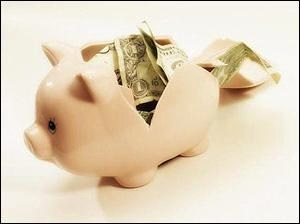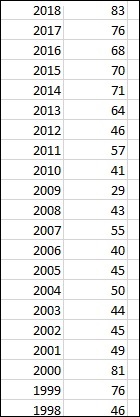By Pam Martens: March 29, 2019 ~
 According to Bloomberg LLP data crunched by the Financial Times, there are more than 300 companies preparing to launch their first ever publicly traded shares known as an Initial Public Offering or IPO in the U.S. Many of these companies have never seen a dime of profits – a harbinger of bad things to come for investors if history is any guide. The IPO stampede seems more motivated by venture capitalists wanting to lock in profits before another stock market meltdown like that which occurred in December than a sincere effort on the part of Wall Street investment banks to bring companies with solid prospects for survival to help boost American jobs and the U.S. economy.
According to Bloomberg LLP data crunched by the Financial Times, there are more than 300 companies preparing to launch their first ever publicly traded shares known as an Initial Public Offering or IPO in the U.S. Many of these companies have never seen a dime of profits – a harbinger of bad things to come for investors if history is any guide. The IPO stampede seems more motivated by venture capitalists wanting to lock in profits before another stock market meltdown like that which occurred in December than a sincere effort on the part of Wall Street investment banks to bring companies with solid prospects for survival to help boost American jobs and the U.S. economy.
A unicorn is a private company valued at more than $1 billion and there will be a number of unicorns IPOing this year if their backers have their way and the stock market doesn’t tank. One of those is the ride-hailing firm Lyft which was priced last evening at $72 a share and will begin its first day of trading this morning on Nasdaq. TechCrunch.com reports that Lyft “posted losses of $911 million in 2018, a statistic that will make it the biggest loser amongst U.S. startups to have gone public, according to data collected by The Wall Street Journal. On the other hand, Lyft’s $2.2 billion in 2018 revenue places it atop the list of largest annual revenues for a pre-IPO business, trailing behind only Facebook and Google in that category.”
Another unicorn prepping for its IPO is Pinterest. Motley Fool writer Chris Neiger reports that Pinterest “lost $63 million in 2018, but that was a huge improvement from its $130 million loss in 2017.” Neiger also notes that another mega unicorn with imminent IPO plans is Uber, another ride-sharing firm. Neiger writes that “Uber lost $1.8 billion in 2018, down from a loss of $2.2 billion the year before, and it could take some time before the ride-sharing company closes the gap between its sales and profits.”
Uber’s losses would seem staggering in a more rational era but there is nothing rational about this market.
Last year Jay Ritter, a finance professor at the University of Florida, provided data showing that 83 percent of all IPOs launched in the U.S. through the third quarter of 2018 had negative earnings. How might these stock offerings fare over the longer term? Comparing data dating back to the 1980s, Ritter told CNBC last year that “The average return on the first day has been about the same, but over the next three years the profitable company IPOs have beaten the unprofitable company IPOs by about 6 percent per year.”
Should American investors actually need historical charts and graphs to figure out that a company showing consistent profits is more likely to outperform a company showing consistent losses? Apparently investors do need a reminder in the United States where Wall Street has an uncanny ability to put lipstick on a pig IPO, convince tens of thousands of retail brokers summoned to attend IPO roadshows to hype the shares to their clients, penalize brokers if their clients want to grab profits on the first day of trading, and where the Wall Street investment bank underwriter can legally prop up IPO stock prices in the early days of trading under what is known as a “stabilizing bid.”
Ritter’s disturbing data shows that the percentage of IPOs with negative earnings in 2018 was the highest percentage since the dot.com bust of 2000, a year in which 81 percent of all IPOs had negative earnings – two percent less than last year. (See graph below.)
Lessons from the dot.com bust should inform today’s investors but, sadly, they have likely been forgotten. One of the key mechanisms used by Wall Street to create artificial demand for lipstick-laden piggy stocks in the dot.com runup was to issue fraudulent research to the public. This is a summary of the charges the SEC brought against Wall Street investment banks in April 2003:
“CSFB [Credit Suisse First Boston], Merrill Lynch and SSB [Salomon Smith Barney] issued fraudulent research reports in violation of Section 15(c) of the Securities Exchange Act of 1934 as well as various state statutes;
“Bear Stearns, CSFB, Goldman, Lehman, Merrill Lynch, Piper Jaffray, SSB and UBS Warburg issued research reports that were not based on principles of fair dealing and good faith and did not provide a sound basis for evaluating facts, contained exaggerated or unwarranted claims about the covered companies, and/or contained opinions for which there were no reasonable bases in violation of NYSE Rules 401, 472 and 476(a)(6), and NASD Rules 2110 and 2210 as well as state ethics statutes;
“UBS Warburg and Piper Jaffray received payments for research without disclosing such payments in violation of Section 17(b) of the Securities Act of 1933 as well as NYSE Rules 476(a)(6), 401 and 472 and NASD Rules 2210 and 2110. Those two firms, as well as Bear Stearns, J.P. Morgan and Morgan Stanley, made undisclosed payments for research in violation of NYSE Rules 476(a)(6), 401 and 472 and NASD Rules 2210 and 2110 and state statutes; and,
“CSFB and SSB engaged in inappropriate spinning of ‘hot’ Initial Public Offering (IPO) allocations in violation of SRO rules requiring adherence to high business standards and just and equitable principles of trade, and the firms’ books and records relating to certain transactions violated the broker-dealer record-keeping provisions of Section 17(a) of the Securities Exchange Act of 1934 and SRO rules (NYSE Rule 440 and NASD Rule 3110).”
Wall Street On Parade previously described the dot.com bust this way:
“As hundreds of court cases, internal emails, and insider testimony now confirm, the dot.com bust turned collusion into an art form. None of the key culprits went to jail in that massive fraud either. Here’s how it went down:
“First, Wall Street brokerage firms issued knowingly false research reports to the public to trumpet the growth prospects for a specific company; second, the firms lined up big institutional clients who were instructed how and when to buy at escalating prices to make the stock price skyrocket. This had an official name inside the walls of the manipulators: ‘laddering.’ Next, managers of the fleets of stockbrokers at the various brokerage firms instructed their flock to stand pat as the stock prices soared. If the stockbroker tried to get his small client out with a profit, he was hit with a so-called ‘penalty bid,’ effectively taking away his commissions on the trade. This sent the clear warning to other stockbrokers to leave their clients in the dubious deals. Only the wealthy and elite were allowed to capture the bulk of profits on these deals.
“One other practice was called ‘spinning.’ This is how the SEC explained that technique in its charges against brokerage firm Salomon Smith Barney: ‘SSB, in a practice known as ‘spinning,’ provided preferential access to hot IPO shares to officers of existing or potential investment banking clients who were in a position to direct their companies’ investment banking business to SSB. The officers sold the shares provided to them for substantial profit. Subsequently, the companies for which the officers worked provided SSB with investment banking business. Executives of five telecom companies made approximately $40 million in profits from approximately 3.4 million IPO shares allocated from 1996-2001, and SSB earned over $404 million in investment banking fees from those companies during the same period.’ ”
Bottom line for today’s investor: Caveat emptor – let the buyer beware.
~~~
Percentage of U.S. Initial Public Offerings with Negative Earnings by Year (Source: Jay Ritter, University of Florida.) 2018 Data Covers First Three Quarters.


